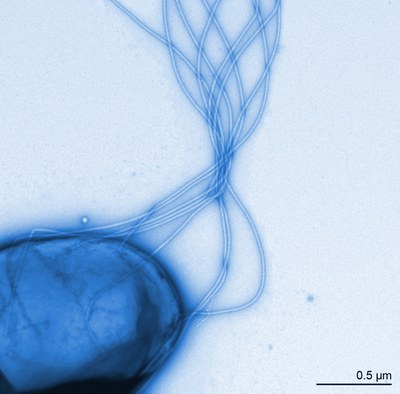Bacteria optimise their swimming behaviour

Elektronenmikroskopische Aufnahme eines Salmonellenbakteriums mit langen Fortsätzen, den Flagellen. Foto: Prof. Dr. Manfred Rhode, Helmholtz-Zentrum für Infektionsforschung, Braunschweig
Bacteria are unicellular organisms that measure just a few micrometres in size. By rotating a propeller-like appendage, the flagellum, they are able to move in liquid environments. This ability to propel themselves is of critical importance for many pathogenic bacteria, such as Salmonella. The motility organelle of the bacteria is a complex, macromolecular structure that comprises thousands of building blocks and measures several micrometres in length.
Interestingly, bacteria can precisely measure the substructures of their flagella on a nanometre scale. In particular, the length of an extracellular joint linking structure – the flagellar hook – is fixed to around 55 nanometres.
To enable this precise length measurement, bacteria use a ‘molecular ruler protein’, which determines the length of the hook structure during the construction of flagella. Why the precisely defined length of the hook structure is important for flagella function, however, was previously unknown.
Researchers at the Humboldt-Universität zu Berlin (HU), together with national and international colleagues from the Helmholtz Centre for Infection Research in Braunschweig, the Braunschweig Integrated Centre of Systems Biology, the University of Edinburgh, the University of Fribourg and Michigan State University, have now determined that the optimal length of the hook structure is critically important for the efficient motility of Salmonella.
As part of this research, the scientists analysed the swimming behaviour of genetically modified bacteria with various hook lengths in different environments and were able to demonstrate that Salmonella can move most efficiently in liquid environments when the hook structure measures around 55 nanometres in length.
These findings are a fascinating example that show why the locomotory organelle of bacteria has developed through the constant process of evolution into the complex, macromolecular structure seen today. The conclusions drawn by the researchers based on the structure of the locomotory organelle with regard to the swimming behaviour of bacteria could also play an important role for the future development of swimming robots at the micrometre scale.
The complete study has been published with the title ‘Hook length of the bacterial flagellum is optimized for maximal stability of the flagellar bundle’ in the scientific journal PLoS Biology.
Prof. Dr. Marc Erhardt
Institute for Biology
Tel.: 030 2093-49780
marc.erhardt@hu-berlin.de
I. Spöring, V.A. Martinez, C. Hotz, J. Schwarz-Linek, K. L. Grady, J. M. Nava-Sedeño, T. Vissers, H. M. Singer, M. Rohde, C. Bourquin, H. Hatzikirou, W. C. K. Poon, Y. S. Dufour, M. Erhardt. (2018) Hook length of the bacterial flagellum is optimized for maximal stability of the flagellar bundle. PLoS Biology 16(9): doi.org/10.1371/journal.pbio.2006989
Media Contact
More Information:
https://www.hu-berlin.deAll latest news from the category: Life Sciences and Chemistry
Articles and reports from the Life Sciences and chemistry area deal with applied and basic research into modern biology, chemistry and human medicine.
Valuable information can be found on a range of life sciences fields including bacteriology, biochemistry, bionics, bioinformatics, biophysics, biotechnology, genetics, geobotany, human biology, marine biology, microbiology, molecular biology, cellular biology, zoology, bioinorganic chemistry, microchemistry and environmental chemistry.
Newest articles

Sea slugs inspire highly stretchable biomedical sensor
USC Viterbi School of Engineering researcher Hangbo Zhao presents findings on highly stretchable and customizable microneedles for application in fields including neuroscience, tissue engineering, and wearable bioelectronics. The revolution in…

Twisting and binding matter waves with photons in a cavity
Precisely measuring the energy states of individual atoms has been a historical challenge for physicists due to atomic recoil. When an atom interacts with a photon, the atom “recoils” in…

Nanotubes, nanoparticles, and antibodies detect tiny amounts of fentanyl
New sensor is six orders of magnitude more sensitive than the next best thing. A research team at Pitt led by Alexander Star, a chemistry professor in the Kenneth P. Dietrich…





















